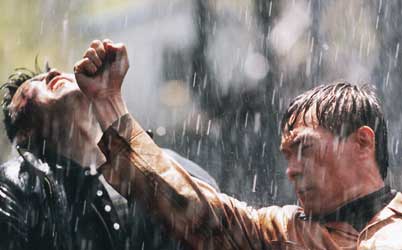KOREAN VICE
SOUTH KOREA’S LEE MYUNG-SE MAY MAKE KINETIC AND STYLIZED ACTION FLICKS, BUT DON’T COMPARE HIM TO HONG KONG ÉMIGRÉ JOHN WOO. CHUCK STEPHENS REPORTS ON THE VERY INDIVIDUAL FILMMAKING OF LEE AND HIS SUNDANCE-NEW DIRECTORS HIT, NOWHERE TO HIDE.
 |
| Park Joong-Hoon (detective Woo) and Ahn Sung-Ki in Nowhere to Hide. |
No matter what the New York Times – or the world cinema scholars at Sundance – seem to think, not all Asian films look alike. Take, for example, South Korean director Lee Myung-Se’s breathlessly paced, brilliantly photographed new policier, Nowhere to Hide. Yes, Lee’s film – which, having gained some momentum up in Park City, was recently included in The Film Society of Lincoln Center and the Museum of Modern Art’s "New Directors/New Films" series, and looks likely for U.S. distribution – is a high-gloss cop-vs.-killer flick, filled with endless chase scenes, gorgeously choreographed free-for-alls, and a shambling, gorilla-gaited lead detective named Woo. But any similarities between director Lee’s film and those of a well-known Hong Kong-gone-Hollywood filmmaker don’t just end there. They never existed in the first place.
Born in 1957, Lee Myung-Se emerged from South Korea’s mid-’80s New Wave – alongside raunchy provocateur Jang Sun-Woo and political historian Park Kwang-Su – as a widely respected visual stylist, as capable at rigging social satires with song-and-dance numbers as he is at dropping the occasional shard of animated mischief into the middle of a romantic comedy. Both a populist and an innovator, Lee makes smart movies for widespread audiences: the two-million-dollar-budgeted Nowhere to Hide, Lee’s sixth film (so much for his being a "new director"), returned 10 million dollars in receipts. How anyone could confuse Lee’s film – with its painterly sense of supersaturated colors, its jagged editing rhythms, and its ingenious resurrection of the Bee Gee’s deliciously mawkish "Holiday" during a screw-turning assassination sequence – with John Woo’s slow-motion essays on the codes of chivalry (as the New York Times did, following the Sundance programmers’ lead) is a mystery to the director himself. If there is a Hong Kong filmmaker Lee feels sympathetic with, it’s Wong Kar-wai – although mainly because Lee thinks Wong’s the one guilty of lifting from him. (Both directors’ first features debuted in 1988.)
Never mind the hobgoblins of "homage" – Nowhere to Hide’s got plenty of style all its own, as when a brutal fistfight lapses into an excuse for cartoon-esque shadow play, or a mud-splattered showdown between Woo (played, decidedly out of character, by South Korea’s top comic actor, Park Joong-Hoon) and his drug-and-death-dealing nemesis, Sungmin (suave superstar Ahn Sung-Ki) becomes a high-grain battle of the titans. Besides, Lee’s legions spend so much time in foot pursuit that a slow-mo swashbuckler like Chow Yun-fat would have long since been left wheezing in the rain.
So what’s in a name? Well, not only is "Woo" an extremely common Korean surname – it literally means "cow" – it can be used to connote someone of a plodding nature. Enter the oafish Detective Woo: his brow lowered, his shoulders swaying, his chin leading the rest of his pear-shaped carcass into one hyperanimated endurance test after another. Where Woo wanders, crime follows. And though his cops may mull over their caseloads with the mindless patience of cattle working their cud, there’s nothing flat-footed about Lee Myung-Se’s filmmaking. Fast, funny, and flashy as hell, Nowhere to Hide is an action flick that jumps effortlessly over the moon.
VOD CALENDAR


 See the VOD Calendar →
See the VOD Calendar →


